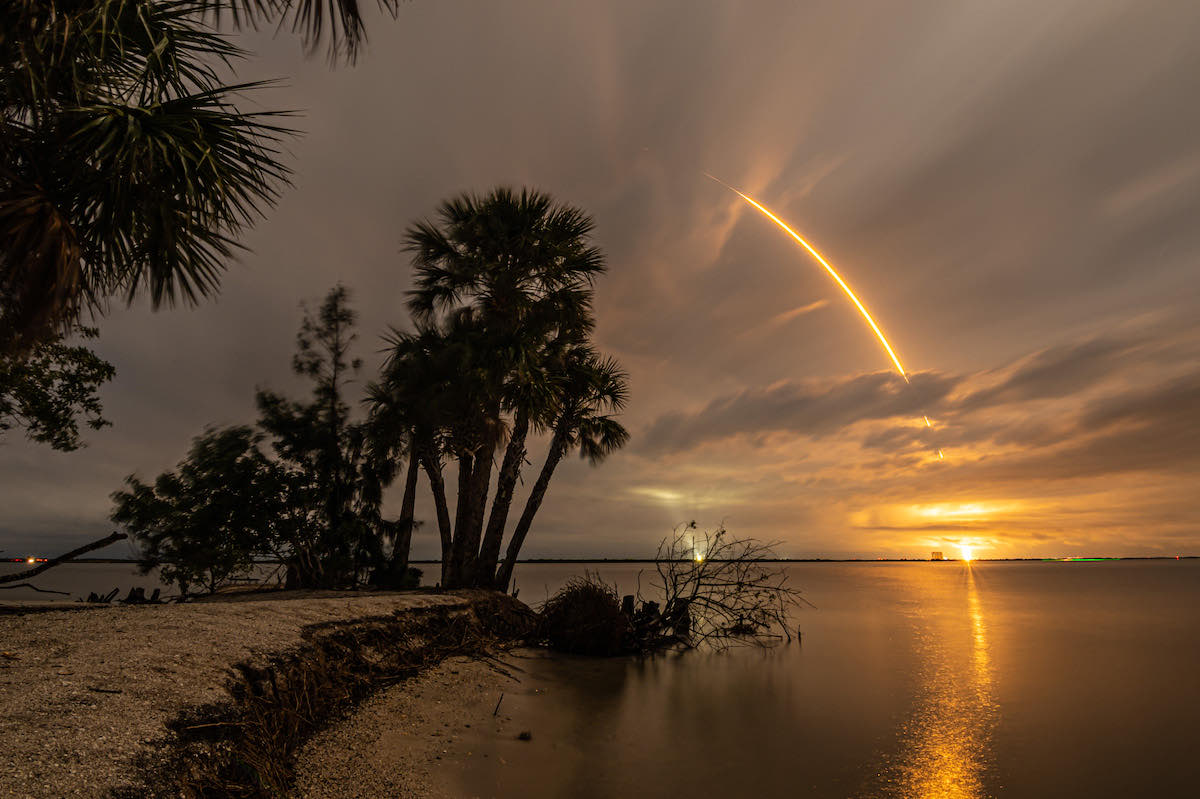
SpaceX flew one of its Falcon 9 rocket boosters for a record 12th time early Saturday, delivering 53 more Starlink internet satellites into orbit and closing out the first quarter of 2022 with 11 missions.
The 229-foot-tall (70-meter) Falcon 9 rocket lifted off from pad 40 at Cape Canaveral Space Force Station at 12:42:30 a.m. EDT (0442:30 GMT) Saturday, following a delay of 1 hour and 19 minutes to wait for thunderstorms to clear the area.
Nine liquid-fueled Merlin 1D engines powered the rocket through clouds over Florida’s Space Coast, as the Falcon 9’s guidance system steered the vehicle northeast over the Atlantic Ocean.
Two-and-a-half minutes into the flight, the Merlin main engines shut down and the first stage jettisoned, clearing the way for ignition of the rocket’s single second stage engine.
The first stage flipped around to descend back into the atmosphere tail first, using a subset of its Merlin engines to slow down for an on-target landing on the drone ship “Just Read the Instructions” positioned in the Atlantic a few hundred miles east of Charleston, South Carolina.
The landing punctuated the 12th flight for this booster, numbered B1051 in SpaceX’s inventory. That sets a new record for SpaceX’s rocket fleet.
The booster debuted in March 2019 with the unpiloted test flight of SpaceX’s Crew Dragon spacecraft, which paved the way for subsequent SpaceX launches with astronauts. The booster has launched from all three of SpaceX’s active pads in Florida and California.
Since the Crew Dragon test flight in 2019, B1051 has launched a mission with three Canadian Radarsat Earth-imaging satellites, SiriusXM’s SXM 7 radio broadcasting satellite, and nine Starlink flights, including Saturday’s mission.
When the current version of the Falcon 9 rocket — known as the Block 5 — launched for the first time in 2018, SpaceX officials said the booster could fly 10 times before requiring major refurbishment. After watching how ground teams refurbished and reused Falcon 9 boosters — and now running on a record of 120 straight successful Falcon rocket launches — SpaceX is now pushing the limits of the rocket’s life expectancy.

The mission Saturday resumed SpaceX’s practice of launching Starlink satellites on paths northeast from Florida’s Space Coast. Since the beginning of the year, SpaceX has launched Starlink missions to the southeast in hopes of better odds that weather and sea conditions would be more favorable for landing of the Falcon 9 booster on an offshore drone ship.
SpaceX said it would fly Starlink missions to the southeast in winter months, placing the rocket landing platform in the Atlantic Ocean northeast of the Bahamas. The trajectory requires the Falcon 9’s second stage to perform an in-flight steering maneuver to ensure the rocket does not fly over Bahamian territory.
The steering maneuver, or “dog-leg,” used up some of the Falcon 9’s lift capacity, limiting its cargo to fewer than 50 Starlink satellites on launches heading southeast. With the change back to launching toward the northeast, the Falcon 9 can carry a full load of 53 Starlink satellites.
While the Falcon 9 rocket’s first stage returned to Earth for landing, the second stage fired its single engine to reach a preliminary transfer orbit. Another burn about 45 minutes after liftoff aimed to place the Starlink satellites into an orbit at an altitude between 189 miles and 197 miles (304-by-318 kilometers), with an inclination of 53.2 degrees to the equator.
A live view from a camera on-board the Falcon 9’s upper stage showed retention rods releasing around 59 minutes after launch, allowing the 53 Starlink satellites to fly free of the rocket.
The Starlink satellites will extend solar arrays and use on-board ion thrusters to reach their operational orbit at an altitude of 335 miles (540 kilometers), where they will enter commercial service for SpaceX.
SpaceX confirms 53 new satellites have separated from the Falcon 9 rocket to join the commercial Starlink broadband network.
This was SpaceX’s 41st dedicated launch for the Starlink network, bringing the total number of Starlink craft launched to 2,335.https://t.co/tqQVHgUL6b pic.twitter.com/bFz2yEmzyj
— Spaceflight Now (@SpaceflightNow) March 19, 2022
SpaceX has launched 2,335 Starlink satellites to date. Including the 53 newest Starlink spacecraft, around 2,086 of those satellites are still in orbit and appear to be working, and the rest have either failed or fallen out of orbit, according to a list maintained by Jonathan McDowell, an astrophysicist who closely tracks spaceflight activity.
That’s nearly five times the number of satellites currently flying in the second-largest fleet of spacecraft — the internet constellation owned by Starlink rival OneWeb. In third place is Planet, which operates a fleet of more than 200 small Earth-imaging satellites.
SpaceX is in the midst of launching around 4,400 Starlink satellites into five orbital “shells” more than 300 miles above Earth. The shells are positioned at different inclinations, and SpaceX completed launches of the first of the five Starlink groups last May.
Ultimately, SpaceX intends to launch as many as 42,000 internet satellites. The final figure hinges on market demand for the Starlink service, which offers high-speed, low-latency connectivity.
SpaceX says the service is best suited for customers in remote, hard-to-reach areas, such as rural communities, isolated homes, islands, and ships. SpaceX has also partnered with the U.S. military to demonstrate Starlink connectivity to airplanes.
SpaceX’s next launch is scheduled for April 1 from Cape Canaveral on the company’s fourth Transporter small satellite rideshare mission.
Email the author.
Follow Stephen Clark on Twitter: @StephenClark1.
